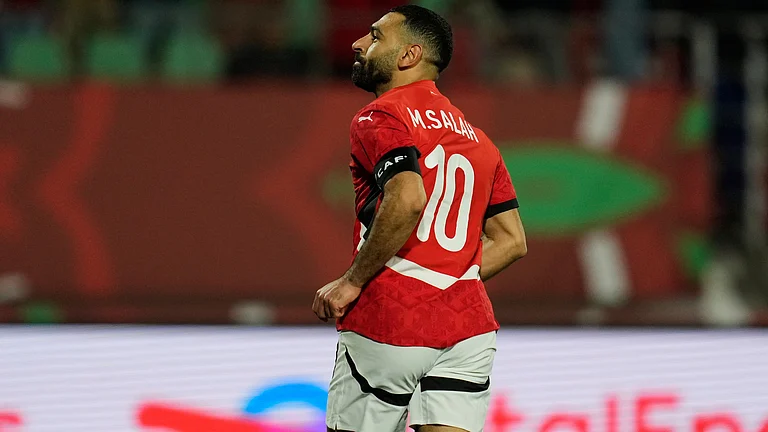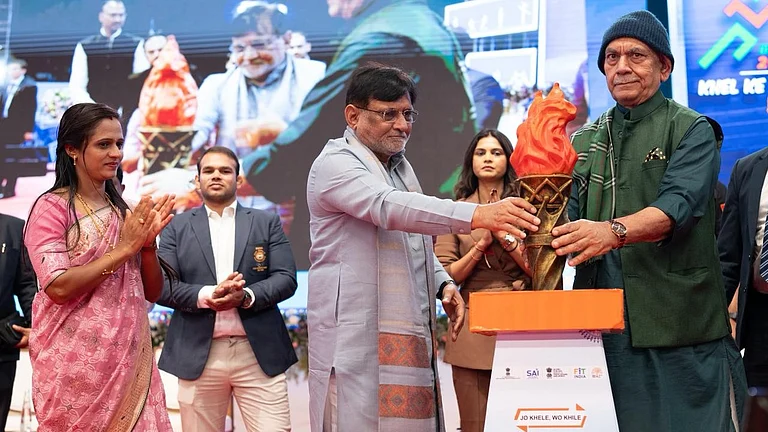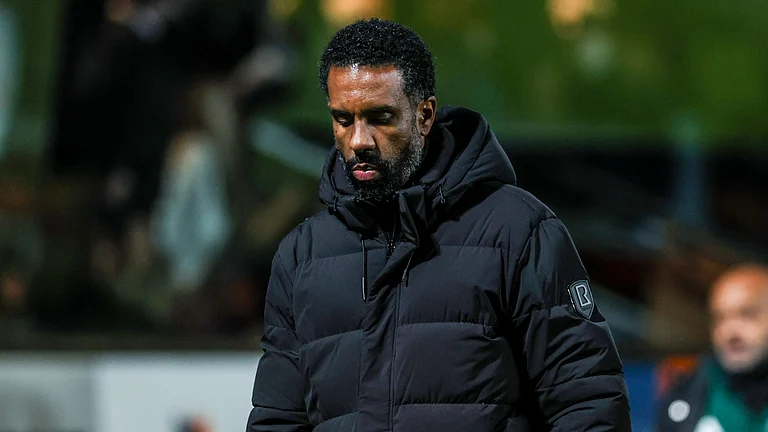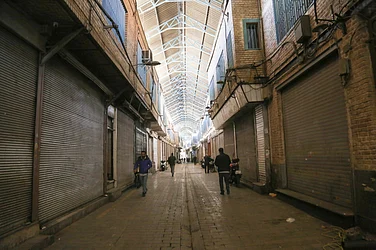In the run-up to any election, all political parties get busy fighting a battle of perception. And since narratives help build perceptions, the prelude to polling is marked by a war of narratives. This war is relentlessly fought either by media organs affiliated to parties or ventures that identify with an ideology or community. Out of the five states where election is being held, Uttar Pradesh matters the most for the sheer size of the electorate: 17 per cent of India’s voters.
The tug of war in the largest state is interesting to watch. Lucknow-based Arun Khote, executive editor of Justice News—a portal that claims to sensitise the masses about atrocities against Dalits by collating reports and analysis about the social group in the mainstream media—has been following this war closely. The BJP is desperate to retain power in UP, but Khote believes it has lost the war of narratives to Samajwadi Party (SP) chief Akhilesh Yadav, who has left the ruling party “dazed and confused” by consolidating the support of MLAs who have jumped ship from the ruling dispensation.
“Till the 2021 West Bengal assembly elections, Opposition parties would fight after the BJP threw in their cards. In this election, however, the cards are being set up by Akhilesh and the BJP is being forced to change tack every now and then,” says Khote, adding that the BJP’s top brass, including UP’s deputy chief minister Keshav Prasad Maurya and national president J.P. Nadda, have been pole-vaulting from one issue to another—from making the Jinnah jibe at Akhilesh to calling for a grand temple in Mathura to the palayan (exodus) of Hindus in Muzaffarnagar, Bulandshahr and Kairana in the wake of the 2013 riots—with the sole agenda of polarising voters.
After the BJP’s clean sweep in the 2017 assembly elections, Swarajya, a magazine dedicated to the liberal centre-right discourse, had weighed in: “The times have thrown the man: Modi. It remains to be seen whether the man can shape the times.” Yogi Adityanath, the fiery Hindutva mascot and Modi’s man in UP, featured on the cover—in saffron robes and Ray-Ban sunglasses, palms raised in the air. The landslide, seen as a thumping mandate for PM Modi, had marked a significant political shift. With UP, 17 out of 28 states had fallen into its kitty and the BJP-led National Democratic Alliance (NDA) had come to rule two-thirds of India’s population. The saffron wave in UP, Bhavdeep Kang wrote in a cover story (April 2017), was possible due to the “diametric vision” that Modi presented to the electorate: “…of communities melded into an overarching Indian identity rather than stratified into clamouring interest groups, shaped by perceived or real oppression.”
If it was “Modi’s charisma” that brought the BJP to power in UP, it is on the wane now, says Ashok Das, editor of Dalit Dastak. Like Khote, he is clued in to zameeni sugbugahat (stirrings on the ground), and the complex caste matrix in a state in which Muslims and Dalits account for over a fourth of the votes. Das has just wrapped up the February issue of the monthly magazine, in which he looks at the impact of defections on the fate of political parties.
When BJP MLAs started shifting their loyalties soon after the announcement of poll dates, Das wrote a piece titled “BJP’s Backward Equation Starts Cracking,” in which he decoded the new development in UP’s ever-changing political landscape: “The BJP is scared of OBC leaders leaving the party because the backward class population in the state is close to 43-45 per cent. In 2017, the BJP had given 125 seats to OBCs. It was because of this that it had won the election. Swami Prasad Maurya leaving BJP is a big setback, because he comes from Koiri-Kushwaha community. The vote share of this community is five per cent, on which Maurya has a strong hold.”
The polls to the 403-seat UP assembly are being held in seven phases—from February 10 to March 7. While the Bahujan Samajwadi Party (BSP) chief Mayawati is not contesting, the two prominent Dalit faces in the fray include Bhim Army chief Chandrashekhar Azad, who is pitted against Yogi from Gorakhpur, and BJP’s Baby Rani Maurya in Agra. Khote says Azad and Baby Maurya will not cause any major dent to the BSP as its votebank remains intact. It’s the BJP’s base that he sees as shrinking. His modus operandi to gauge this is the response to his posts on social media: “BJP workers and its IT Cell don’t seem to be as active as they were in 2017. Earlier, I would write two lines against BJP and a stream of abuses would follow. Now, I write paragraphs and they go unnoticed.”
Given a strong undercurrent of anti-incumbency, the possibility of a wave for the BJP seems remote in 2022. On February 2, an editorial in Dawat, an Urdu weekly run by Jamaat-e-Islami, cites the reasons for people’s disenchantment with the party: “What the party did to farmers when they were protesting is known to all. Now, the Union home minister is going from door to door, pleading for support from them… There is no development work on the BJP’s agenda. It has failed miserably at all essential fronts. And that is why it’s resorting to its tried and tested weapon: hatred. Its ministers are busy whipping up a communal frenzy.”
For Moin Khalid, one of the editors at Dawat, the publication’s effort is to present the “right” perspective before readers. It strives not to “communalise” its coverage of elections, educating people “sensitively” so that polls are not looked at from a communal angle. “We would rather not react to or write about issues that create disharmony or disturb the communal fabric of society,” Khalid says. India Tomorrow, a sister concern of Dawat, has a similar approach. “We do not rely on news reports by agencies, but physically visit places we write about. This, despite the fact that we operate under several constraints,” says Syed Khalique Ahmed, editor of India Tomorrow.

Needless to say, the points of view of media outlets owned and run by the marginalised, are in sharp contrast with RSS mouthpieces like the Organiser and Panchjanya, even though they seem to have a lesser degree of conviction about BJP improving upon its 2017 performance. The January 23 issue of Organiser features an interview with Manipur CM N. Biren Singh, in which he declares his poll plank as “development, delivery and harmonious coexistence”. Treading cautiously in the editorial, Prafulla Ketkar sees the elections in the five states—UP, Uttarakhand, Manipur, Goa and Punjab—as a complex mix of local, regional and national issues. The BJP will contest in all 60 seats in Manipur and Organiser predicts 40-plus seats for the party. Ketkar, however, underlines that the outcome of the elections will depend a great deal on “local considerations and performance of state governments and MLAs”. He writes that as a cadre-based party that continuously experiments with its outreach through technology, the BJP was better prepared for campaigning during the pandemic, often setting larger election narratives.
An analysis by Kishore Kumar Malviya in the same issue shines light on the voters’ perennial paradox of choice: “choosing the best of the worst or none”. He sees the UP elections as a proxy of what we should expect when the country goes to polls two years later. With 80 Lok Sabha seats, the battle for UP is both the “barometer” and “rainmaker” for the 2024 general elections. Echoing Ketkar, Malviya writes that the BJP’s twin planks in UP are likely to remain development and—no prize for guessing—Hindutva. Having delivered its promise to construct Ram Temple in Ayodhya, the BJP has made its intention quite clear on Kashi and Mathura. Isn’t it a trump card in the party’s arsenal, an arrow in its quiver that it can pull out at will when everything else fails? Was it for nothing that the PM recently photographed himself showering flower petals on workers who built the Kashi-Vishwanath Corridor, and of sharing a meal with them? “Election issues are like bubbles. We mustn’t make too much of what the parties talk about before the polls. No matter what the BJP says or does, we should never forget it champions diversionary tactics and is a pro at image-building,” Khalid says.
Besides development, BJP’s poll planks across the five states are variations on the themes of antodaya (the rise of the last person), suraksha (security) and samman (dignity). In the four states where it is in power, the party is confident of being re-elected. In the 40-member Goa assembly, it hopes to get 22-plus seats. In his cover interview to Organiser (February 6), BJP’s face in Goa, CM Pramod Sawant, says: “With the help of the central government, the double-engine government in the state has carried out a quantum of development in Goa in eight years that didn’t happen in the previous 50.” Asked about his achievements, he enlists: “Security, tap water in every house and end to open-defecation.”
The key issue for the BJP in this election is making Goa swayampurna (self-reliant), as the Organiser highlights. Sawant promises if his government is re-elected, mining activities and ore extraction, which were stopped in the state in 2012, will resume “on a large-scale”. At the same time, he makes it clear that he will also promote “temple tourism” to showcase the state’s “real culture”. By throwing its hat in Goa, the Mamata Banerjee-led TMC, with its slogan of “Goenchi Navi Sakal (Goa’s New Dawn)”, has made the battle in the state tough for the ruling party. In his analysis, Giririaj Pai acknowledges the emergence of TMC as a major player in Goa, with its “hoarding blitzkrieg that took the state by storm”. The highlight of the latest issue of Organiser, however, is a four-page analysis on UP, titled, “The Monk Who Has Moved Mountain”, in which Pankaj Jagannath Jayswal extols Yogi for showing “extraordinary commitment to obliterate backwardness and bring the state of 22 crore-plus people on the fast track of development through his mantra of “Reform, Perform, Transform”. UP, the Bimaru state, has become socio-economically progressive, he writes.
Panchjanya’s line is not too different. Its January 16 issue features Uttarakhand CM Pushkar Singh Dhami on the cover. The weekly lauds him for taking “550 decisions in six months”. Singh tells Panchjanya editor Hitesh Shankar and Uttarakhand bureau chief Dinesh Mansera that nationalism and Hindutva “run in his blood and course through his veins”.
In its latest issue (February 6), it strikes a note of optimism about BJP making inroads in Punjab, where Dalit Sikh Charanjit Singh Channi is the Congress’ CM face.
When Modi had “parachuted” Yogi and made him the UP CM, it was explained away as an experiment to give positions of authority to those who came with no mandate. This experiment was repeated in Maharashtra when they put Devendra Fadnavis in the saddle. Khalid says: “Why did all these men have to be from the upper caste? Mayawati is accused of politics of identity, but this selective selection too reeks of the same.” If BJP sees itself as an “election-winning machine”, Khalid wonders what would happen if this machie were to “run out of fuel”?
The answer will be known on March 10.
(This appeared in the print edition as "The Other Voices")


























